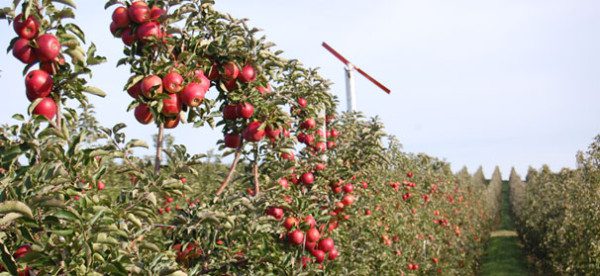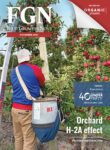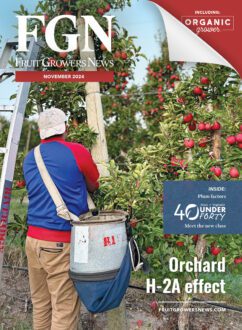
Jan 25, 2013Protecting your fruit from frost and freeze
After the damaging frosts and freezes many endured in 2012, growers are looking at frost prevention methods coming into 2013. This led to a packed house at the 2012 Great Lakes Fruit, Vegetable & Farm Market EXPO in Grand Rapids, Mich., for a session covering weather risk management.
There are a few things growers need to know to effectively initiate frost protection. One thing is the temperature at which catastrophic damage will occur. This is different for different types of crops, but is usually between 22˚ F and 32˚ F.
Another is the location of the inversion layer. Cold air sinks below surrounding air, and when a frost event occurs there is a layer of cold air hugging the ground. The inversion layer is the point where the coldest air at ground level meets warmer air above it, much like a fog bank. Knowing where the inversion layer typically forms is a vital part of protecting crops from frost, Evans said. This can typically be achieved with weather monitoring equipment.
According to Robert Evans, a research agricultural engineer with USDA’s Northern Plains Ag Research Lab in Sidney, Mont., there are two basic types of frost avoidance strategies growers can incorporate: passive and active.
Passive protection
Passive frost protection can minimize risk, decrease the probability or severity of frosts and freezes, or cause the plant to be less susceptible to cold injury. These practices include site selection, variety selection and multiple cultural practices, Evans said.
“The best time to protect a crop from frost is before it is planted, and good site selection is the most effective passive risk-avoidance strategy,” he said.
Good site selection for frost protection includes air drainage. The availability of natural heat sources, such as large water bodies and rivers, can help make the site a good choice. Quite often, the most limiting factor is the price of land, Evans said.
“Obtaining a good site with good air drainage, especially in a premier growing area, can be very expensive, but it is often an investment with a very high rate of return.”
Active protection
Active frost protection is getting a lot of attention now, Evans said. Active management comes in three basic areas: the addition of heat, the mixing of warmer air from the inversion layer under radiation frost conditions, or the conservation of heat from the plant. The amount of time, energy and money spent on one of these techniques, however, doesn’t always equal the reward, Evans said.
The use of sprinklers or heaters adds heat.
Over-tree sprinkler systems can provide the highest level of protection, Evans said. The key to using water is to continually use it to form clear ice. Clear ice means that an endothermic reaction is taking place and the warmth of the plant is being trapped inside it. If the ice starts to become cloudy, the plant is losing heat and damage can occur. Spraying water must continue the entire time the freeze event is taking place, and the sprays must keep going from before there is a freeze event that would damage the fruit until the ice is completely melted from the tree after the event, Evans said. If the water stops spraying on the clear ice, it goes from being endothermic to exothermic, and the heat loss and ice will damage the fruit.
“Because of the large amounts of water required for over-tree sprinkling for frost protection, some growers have attempted to spread overhead water applications by wide spacing of sprinkler heads, cycling of water applications on and off, or misting techniques to reduce the total water supply needs across a block,” Evans said. “However, these techniques do not apply adequate water directly to the plant canopy to account for evaporation, and these systems are not recommended because of the high level of risk.”
Under-tree sprinkler success is influenced by how strong the temperature inversion is and where it is located in the air column, the amount and temperature of the water applied, the volume of air flow through the orchard, the release of latent heat from the freezing of the applied water and the radiant heat from the soil, Evans said. The air flowing through the orchard can be affected by fans and other measures and can actually rob heat from the water and trees, Evans said. The two systems work very well with each other, as under-tree sprinklers are less likely to have massive heat losses due to air movement.
Heaters placed around the orchard are another way to add heat. Heat guns, small gas-powered heaters or even the burning of organic materials such as wood or hay have been used for some time with varied success, Evans said. Using a heater alone, however, is one of the least effective frost prevention methods. This is because heat rises, and heaters can’t cover a large area.
Evans said it is more efficient to use many smaller heaters instead of large, central heat sources. Contrary to belief, clouds of smoke offer no protection whatsoever from frost. Still, it takes anywhere from 40 to 60 heaters per acre to survive a frost event. If heaters are used, Evans suggests adding other elements, such as sprinklers or fans.
Frost fans get air from the inversion layer down into and mixing with the freezing air at ground level. They have gained in popularity lately, because they can be used at any time and are energy efficient, Evans said. Frost fans, on average, cover 10 to 13 acres per fan.
Amy Irish-Brown, an Extension educator with Michigan State University (MSU), said that in the past year she has seen the number of permanent frost fans in her area increase by a factor of 10 or more.
“Where there used to just be a few, now they are going up everywhere,” she said. “They aren’t cheap, running anywhere from $16,000 to $35,000 each, but for many growers it beats the alternative.”
The problem with fans, Evans said, is that if the inversion layer is higher than the height of the fan, it can’t pull down the warmer air and is ineffective. Site selection is a key element when placing a fan. Portable fans can be used effectively too, he said, especially when used with other methods like sprinklers.
Another method of frost prevention is using helicopters to hover over the orchard during a freeze event. The rotors pull the air down from the inversion, Evans said.
The use of helicopters is a last resort kind of measure, Irish-Brown said. The cost is extremely prohibitive and there are many safety and noise factors to take into account. Renting a helicopter can run an average of $1,600 per hour, she said. They can cover a large area, up to 40 acres per helicopter, but the cost can quickly reach astronomical levels for a single use.
Perhaps most importantly, growers need to know the weather conditions and pay careful attention to what’s going on outside, said Beth Bishop, the coordinator of MSU’s Enviro-weather program.
“Minimizing weather risk requires knowledge,” Bishop said. “Growers need to know the current weather conditions and have an idea of what they will be in the near future. Growers must also understand the cumulative effects of previous weather conditions.”
For more information about Enviro-weather, visit www.enviroweather.msu.edu.
For more on what happened during the spring of 2012, click here.
By Derrek Sigler, Assistant Editor














